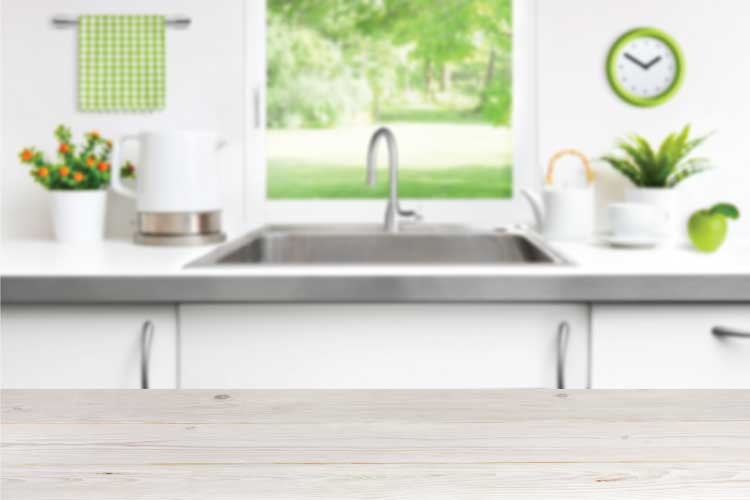Green Up Your Kitchen For Your Family’s Sake
When families get together in someone’s home, where do you think most of the action takes place? Well, unless there is no food involved in your life, chances are high that in situations like these and many others, the kitchen plays an integral role in the home, for it’s where food and drinks are prepared in. If you haven’t already done so, perhaps it’s time to take a good look at your kitchen and see if it’s well-maintained, free from toxins and reflects the heart of its cook.
Ease off the cleaning chemicals
None of us like a grimy, dirty kitchen, and that’s understandable. As a home-proud cook, you’d surely want to have the heart of your home looking clean and presentable. Still, as you probably know by now, most of the household cleaning products in the market, although effective in their jobs, are also quite effective in killing off your immune system and poisoning your home with their toxic fumes! Just take a look at the label of a typical kitchen cleaning product – chances are, there is a list of ingredients that are difficult to pronounce. These are harmful chemicals. They simply have no business coming to contact with you, your kitchen or with the air, your family breathes!
For any kind of cleaning up in the kitchen or anywhere else in the house, avoid products with labels that resemble a page of a chemistry textbook, and instead, look for organic or plant-based cleaners with no artificial fragrances, especially. Look for a brand that has your family and Mother Earth at heart.
Environmental impact of modern, conventional kitchens
- Use of too much energy as the result of poor appliance choices
- Overconsumption of water due to oversized dishwashers
- Chemical sensitization due to overexposure to emissions from varnish, insulation and flooring products containing formaldehyde
- Overconsumption of energy due to poor natural lighting and conventional light bulbs
- Poor air quality due to inadequate ventilation
- Excessive use of environmentally degrading cleaning products (e.g., chlorine bleach, ammonia) because of high-maintenance surfaces and floors
- Too much rubbish accumulating due to lack of space for storage of recyclables and compostables
Start ditching those plastic containers
More and more studies are connecting certain plastics to health problems, with No. 3 (PVC) and No. 7 plastics that contain bisphenol A (BPA) raising the most warning flags. BPA is also found in many plastic takeout containers. No. 6 plastics (polystyrene, also known as Styrofoam) also leach chemicals into food and drink. While Nos. 1, 2, 4, and 5 plastics are considered safer options, consider storing your food in glass containers, and choosing a stainless steel reusable water bottle for bringing beverages on the go.
The green issue with most kitchens
Energy consumption is right at the top here, for the kitchen is the most energy-intensive room in the house. Oversized and energy-inefficient appliances are the number one problem with conventional kitchen remodels. We have to ask ourselves if we really, honestly need a refrigerator that can hold way more food that your family needs, for example. Also, how big do we really need that microwave to be? Will we be defrosting large amounts of food all year around, or do we merely reheat small containers of leftovers?
Pick better ingredients for your cooking
Food serves as the centrepiece of our kitchen, the thing that brings us all together. To keep the safest choices on hand, choose organic whenever you can. Pesticides commonly used in conventional agriculture contain dozens of hormone-disrupting chemicals that studies have linked to diabetes, Parkinson’s disease, developmental problems, and even cancer. Paying a bit more attention to the ingredients in your cooking and also making an effort to seek out organic produce also means you’re omitting the chances of serving genetically modified food to your precious family and guests.
Choice of stove
A gas stove is considered a greener option than an electric stove because it creates instant heat and utilizes instant heat control. More recent gas stoves that use electric ignition can reduce gas use up to 40 percent in comparison to those that use traditional pilot lights.
A gas stove costs less to operate than an electric stove. Additionally, a gas stove can be lit with a match so that you can still prepare meals during power outages.
When it comes to food safety, it’s literally in your hands
Contrary to popular belief, foodborne illnesses, including salmonella and E. Coli infections, aren’t just the results of dining out at places that don’t practice proper hygiene protocols, but they may also result from poor food handling at home, right in your own kitchen! While a 20-second plain-water rinsing of your fresh produce before preparing or cooking may seem good enough, but for better protection, try this: Mix 1 tablespoon lemon juice, 2 tablespoons distilled white vinegar, and 1 cup cold tap water in a spray bottle, shake well and apply to your produce. Rinse with tap water before cooking or serving. Also, remember to wash your hands before handling or preparing food. Tip: Invest in an organic hand wash for this purpose. Alternatively, you could purchase a big bottle of organic liquid castile soap, add a few drops of your favourite essential oils and use that instead.
Innovative ideas for a greener kitchen
- Lots of operable windows for natural daylight and free ventilation
- A receptacle for compostable materials located at arm’s length to meal prepping spot
- Easy access to recyclables storage in the kitchen (and sufficient room for them too)
- If you must have one, opt for a dish-drawer dishwasher, which is great for smaller loads
- A decently sized, energy-efficient refrigerator/freezer
- Hardwood floors, which are easier to stand on than stone or tile, have no grout to clean and mop up easily with soap and water
- A place to grow herbs
- Storage designs that are sufficient and easy to use, but don’t encourage you to hoard
- A cold box, which keeps fruits and veggies such as apples and potatoes fresh without requiring refrigeration
Consider your pots and pans
Do a background check on the make of your pots and pans and ensure that they do not contain perfluorinated chemicals that some studies have linked to serious health issues which include fertility problems. If your present cookware happens to contain them, and you’re not ready to replace them just yet, then make it a point to cook using the lowest heat you can manage with – it may take a little more time, but it may turn out for the best. Avoid scratching the surface of your cookware too. When you’re ready to replace them, look for unseasoned cast iron, stainless steel, or heat-proof glass cookware.
Check your water
Water from our taps is generally safe for consumption, but not everyone likes the idea of drinking tap water. For extra protection, or if you don’t like the taste from the tap, look for reputable water filter machines that are energy efficient. Make sure you have your water tested at least annually to make sure it’s free of harmful bacteria, viruses, and chemicals. If necessary, choose a water filtration system based on the test results.
Repel insects naturally
Your kitchen is where all those yummy food is, so naturally, bugs and insects are bound to visit! Place foods that are kept outside the refrigerator into sealable storage containers to keep insects away from them. If your kitchen seems to be attracting too many of these unwanted creatures, try these tips:
Put several drops of Eucalyptus oil on ribbon or cloth strips and hang them near doors or windows to keep flies at bay. If ants are your problem, try placing mint leaves around the perimeter of your kitchen. You can also try mixing a 50/50 solution of vinegar and water in a spray bottle and use it as a spray and wipe solution to as the final wipe on tables, cabinets, kitchen counters and anywhere else in the kitchen that bugs and insects seem to be fond of.
Your health may benefit too!
Consider this: Which would be your choice? To prepare your family’s meals in a dark, gloomy kitchen, or in a cheerful, bright one? When it comes to your mental or emotional wellbeing, especially, which do you think will benefit you?
And what of physical health outcomes, you may be wondering? In this regard, going green in your kitchen, as well as the ongoing use of a green kitchen brings us less or no exposure to toxic chemicals (such as finishes, paints, cleaning products, etc.); lower injury rates (because appliances are smaller and materials safer). Depending on the layout of your kitchen, perhaps you may be able to get more exercise as you walk to and from while delivering recyclables, compostables and waste materials to their appropriate bins.
How the green approach can save you money
- Money can be saved from the very start if you consider installing and using smaller appliances, resisting overbuying kitchen appliances, furniture, and decorations, etc.
- You could also look around for second-hand cabinets or salvaged materials that you can reinvent into your own pieces of furniture.
- Operating and maintenance costs are reduced by using energy-efficient kitchen appliances (e.g., refrigerator, freezer, dishwasher, microwave).
- Keep in mind that by being able to clean surfaces and floors with soap and water rather than special chemical formulations, you will not only be saving costs, but the environment too, for many of these cleaning solutions contain harmful chemicals that linger in the indoor air that your family breathes.
- Money can also be saved by using natural daylight and ventilation instead of artificial lighting and mechanical ventilation.





















Leave a comment